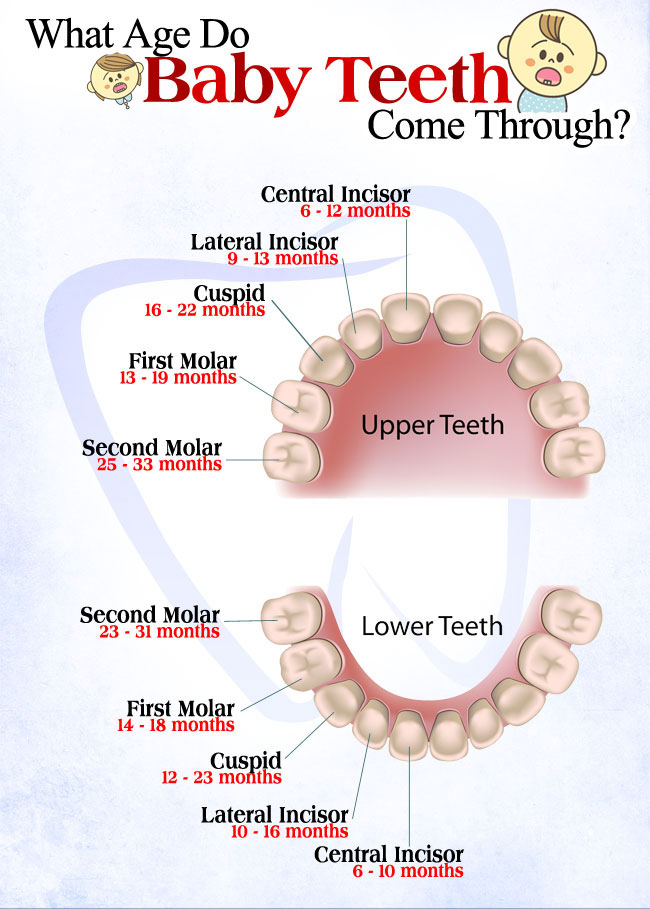
What Age Do Baby Teeth Come Through? – Infographic
Introduction to Baby Teeth
Contents
Baby teeth, also known as primary or deciduous, appear in the mouth between 6 and 12 months of age. They typically start with the two bottom front teeth (central incisors) and the four upper front teeth (lateral incisors). The rest of the baby teeth will arrive in pairs over the next few years until all 20 primary teeth are present by age 3.
It is essential to take good care of baby teeth, even though permanent adult teeth will eventually replace them. Baby teeth help children chew and speak properly, hold space for adult teeth, and guide them into position when they come through. Good oral hygiene habits should be established early on to ensure healthy primary and permanent teeth development.
If you have any concerns about your child’s dental development, it is best to consult a dentist who can advise on proper oral hygiene practices and answer any questions you may have.
An infographic showing the age at which the baby’s teeth come through. With this chart, you will know when to expect your child’s teeth to appear in their mouth.

On the upper teeth, the central incisor appears within 6-12 months, while the lateral incisor is 9-13 months. The cuspid grows between 12 – 13 months. The first molar starts growing at 13 – 19 months, and the second molar grows later at 25 – 33 months.
For the lower teeth, teeth grow at a different rate compared to the upper teeth. The central incisor appears at 6-10 months, and lateral incisor grows at 10 – 16 months. Cuspid grows in 12 – 23 months. The first molar grows in 14 – 18 months and is followed by the growth of the baby’s second molar within 23 – 31 months.
Timing of Tooth Eruption
The timing of Tooth Eruption is an excellent indicator of dental health in babies and toddlers. Knowing when to expect the first tooth, or primary dentition, to emerge can help parents monitor their children’s oral development and take proactive steps if necessary.
Primary teeth typically begin to erupt between 6 and 12 months of age. In most cases, the lower central incisors appear first, followed by the upper central incisors within a few months. As baby teeth continue to emerge over the course of 18-24 months, parents should look for signs such as swollen gums or white spots on the gum line indicating a tooth is about to break through. If primary teeth do not appear at this expected time frame, it may indicate that something else is going on with your child’s dental health, and further evaluation from a dentist may be needed.
What Types of Teeth Come Through First?
Knowing when to expect certain types of teeth to come through is essential for parents and caregivers. Different types of baby teeth will come out at different times, beginning with the two bottom front teeth.
Typically, these front two lower incisors are the first set of baby teeth that will appear in your infant’s mouth around six months old. Shortly after, the top four incisors will start coming in around 8-12 months old. Following this, you can expect your child’s molars appearing in their mouth from 18 months to three years old. After this age, it is common for children to experience their canine or eye tooth stages between 16-23 months of age.
Oral Care Tips for Baby Teeth
Brushing your baby’s teeth can be an intimidating experience. But it’s important to establish good oral care habits from the get-go. Healthy baby teeth are the foundation for healthy adult teeth and mouth health throughout life, so start early and practice these tips to keep your little one’s mouth healthy.
First, visit a pediatric dentist soon after your baby’s first tooth appears. The American Academy of Pediatric Dentistry recommends that all children visit a dentist by their first birthday, as cavities in young children can lead to severe issues like infection or even hospitalization due to dehydration if not managed properly.
To brush your child’s teeth, use a soft-bristled toothbrush and a pea-sized amount of fluoride toothpaste twice daily – once in the morning and once at night before bedtime.
When Do Baby Teeth Begin to Shed?
It’s an exciting time when a child’s baby teeth start to come in. But as exciting as it is for the child and their parents, those same baby teeth will eventually begin to shed. Knowing when this begins and the timelines involved can help parents prepare for what’s ahead.
Shedding baby teeth typically starts at around six years of age, with the lower central incisors being the first to go. This is usually followed by the upper central incisors a few months later than a few other front teeth over the following six months. The back molars are among the last permanent teeth to come in, usually between ten and twelve years old.
What Age Do Lower Adult Teeth Come Through?
- Central incisors – 7 to 8 years old
- Lateral incisors – 8 to 9 years old
- Canines – 11 to 12 years old
- First premolars – 10 to 11 years old
- Second premolars – 10 to 12 years old
- Wisdom teeth – 17 to 21 years old
What Age Do Lower Adult Teeth Come Through?
- Central incisors – 6 to 7 years old
- Lateral incisors – 7 to 8 years old
- Canines – 9 to 10 years old
- First premolars – 10 to 12 years old
- Second premolars – 11 to 12 years old
- Wisdom teeth – 17 to 21 years old
Benefits of Taking Care of Baby Teeth
Baby teeth provide a placeholder for adult teeth, so they must be taken care of and maintained as soon as they appear. Good dental hygiene habits at an early age can help prevent cavities, gum disease, and other issues that can arise from poor oral health.
Parents should consider several benefits to taking proper care of baby teeth when teaching their children the importance of brushing and flossing regularly. First, good oral hygiene habits will help build a foundation for healthy permanent adult teeth. Children who take proper care of their baby teeth have less risk for cavities and other dental diseases throughout childhood.

